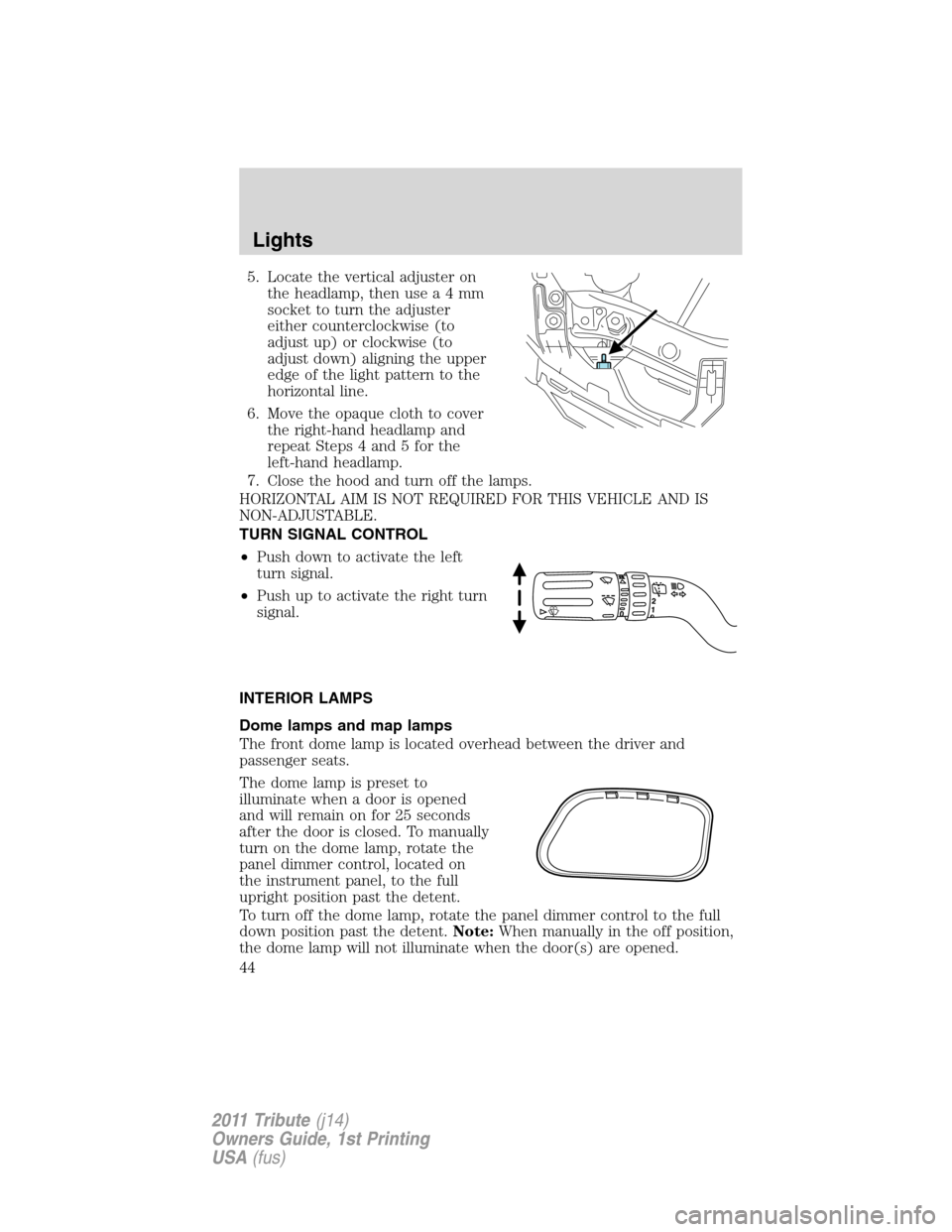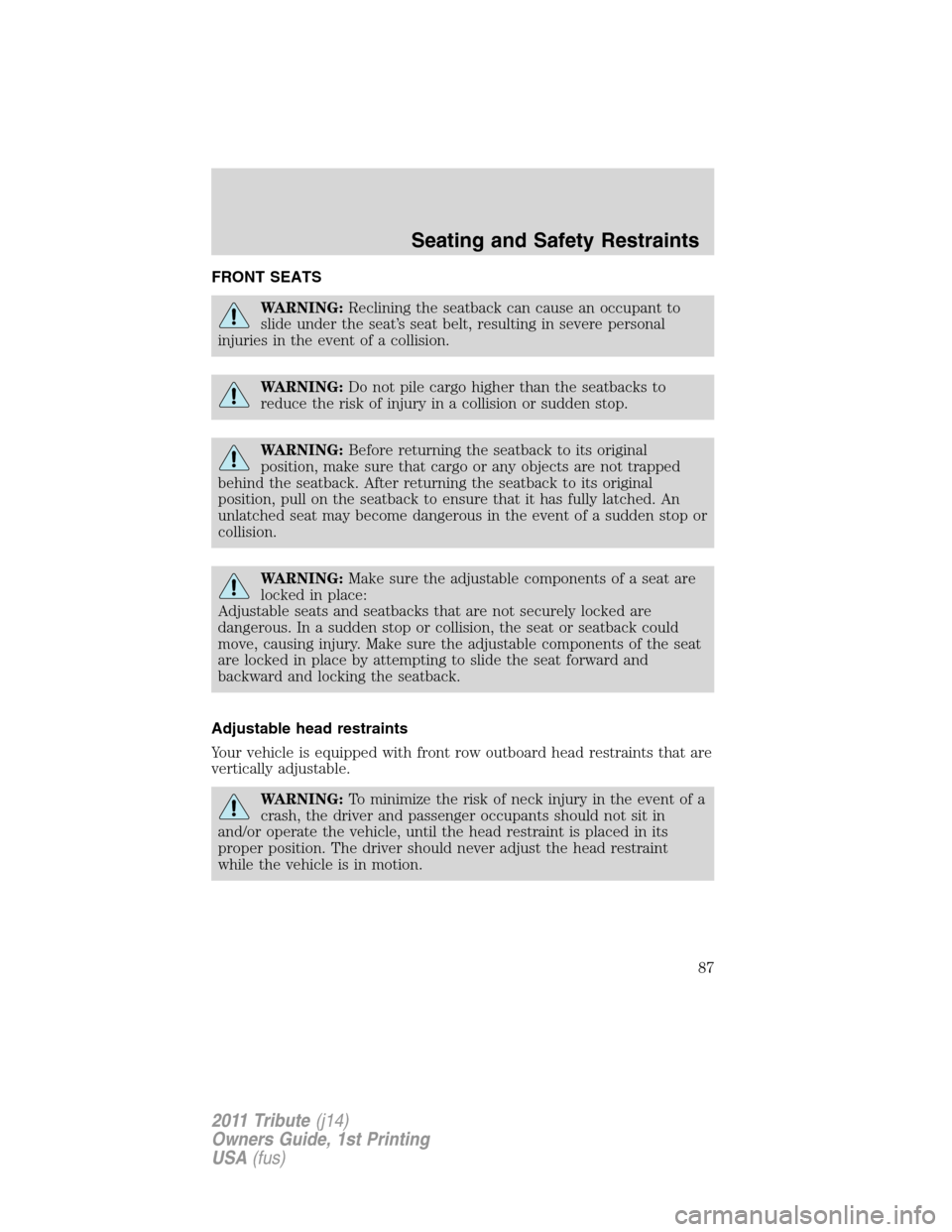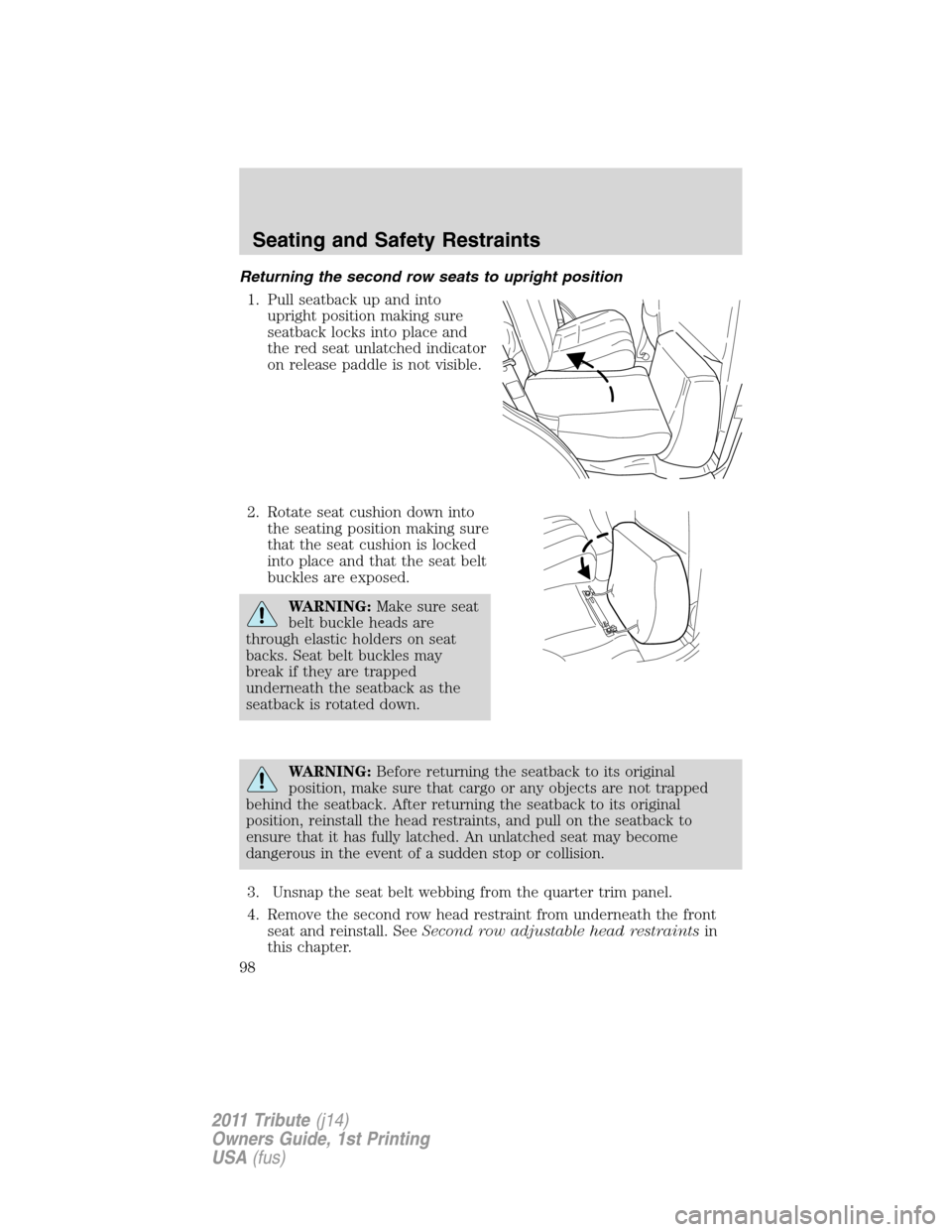seats MAZDA MODEL TRIBUTE 2011 Owners Manual (in English)
[x] Cancel search | Manufacturer: MAZDA, Model Year: 2011, Model line: MODEL TRIBUTE, Model: MAZDA MODEL TRIBUTE 2011Pages: 320, PDF Size: 2.08 MB
Page 6 of 320

Do not add friction modifier compounds or special break-in oils since these
additives may prevent piston ring seating. SeeEngine oilin the
Maintenance and Specificationschapter for more information on oil usage.
SPECIAL NOTICES
Emission warranty
The New Vehicle Limited Warranty includes Bumper to Bumper
Coverage, Safety Restraint Coverage and Corrosion Coverage. In addition,
your vehicle is eligible for Emissions Defect and Emissions Performance
Warranties. For a detailed description of what is covered and what is not
covered, refer to theWarranty Guidethat is provided to you along with
yourOwner’s Manual.
Special instructions
For your added safety, your vehicle is fitted with sophisticated electronic
controls.
WARNING:Please read the sectionAirbag Supplemental
Restraint System (SRS)in theSeating and Safety
Restraintschapter. Failure to follow the specific warnings and
instructions could result in personal injury.
WARNING:Front seat mounted rear-facing child or infant seats
should NEVER be placed in front of an active passenger airbag.
Notice to owners of pickup trucks and utility type vehicles
WARNING:Utility vehicles have a significantly higher rollover
rate than other types of vehicles.
Before you drive your vehicle, please read this Owner’s Manual carefully.
Your vehicle is not a passenger car. As with other vehicles of this type,
failure to operate this vehicle correctly may result in loss of vehicle
control, vehicle rollover, personal injury or death.
Using your vehicle with a snowplow
WARNING:Do not use this vehicle for snowplowing.
Your vehicle is not equipped with a snowplowing package.
Introduction
6
2011 Tribute(j14)
Owners Guide, 1st Printing
USA(fus)
Page 27 of 320

The default setting isoff.
Use
SEEK/TRACKto adjust between SPEED OFF and levels
1–7:Increasing the level from 1 (lowest setting) to 7 (highest setting)
allows the radio volume to automatically change slightly with vehicle
speed to compensate for road and wind noise.
Recommended level is1–3;SPEED OFF turns the feature off and level 7
is the maximum setting.
ALL SEATS (Occupancy mode, if equipped):Press SOUND
repeatedly to reach the Occupancy mode setting. Press
SEEK/TRACKto select and optimize sound for ALL SEATS,
DRIVERS SEAT or REAR SEATS.
Extra Features
AUX:Press to reach LINE IN (auxiliary audio mode).
For location and further information on auxiliary audio mode, refer to
Auxiliary input jacklater in this chapter.
(Phone):This feature is not active.
TUNE/OK:Your vehicle may be
equipped with features which will
require you to confirm commands
by pressing OK.
Auxiliary input jack (Line in)
WARNING:Driving while distracted can result in loss of vehicle
control, accident and injury. Mazda strongly recommends that
drivers use extreme caution when using any device or feature that may
take their focus off the road. Your primary responsibility is the safe
operation of the vehicle. We recommend against the use of any
handheld device while driving and that you comply with all applicable
laws.
Entertainment Systems
27
2011 Tribute(j14)
Owners Guide, 1st Printing
USA(fus)
Page 37 of 320

10.Passenger heated seat control (if equipped):Press to
activate/deactivate the passenger heated seat. SeeHeated seatsin
theSeating and Safety Restraintschapter.
11.
Recirculated air:Press to activate/deactivate air recirculation
in the vehicle. Recirculated air may reduce the amount of time
needed to cool down the interior of the vehicle and may also help
reduce undesired odors from reaching the interior of the vehicle.
Recirculated air engages automatically when MAX A/C is selected or
can be engaged manually in any airflow mode except
(defrost).
Recirculated air may turn off automatically in all airflow modes
except MAX A/C. When the ignition switch is turned off and back on,
the climate system will return to the recirculated air mode only if
the A/C button LED is illuminated and the air distribution selection
is either
(panel) or(panel/floor). Recirculation may turn off
automatically in some airflow modes to reduce fog potential.
12.MAX A/C:Distributes recirculated air through the instrument panel
vents to cool the vehicle. This re-cooling of the interior air is more
economical and efficient. Recirculated air may also help reduce
undesirable odors from entering the vehicle. Press the MAX A/C
button again for normal A/C operation.
13.A/C:Press to activate/deactivate air conditioning. Use with
recirculated air to improve cooling performance and efficiency.
Engages automatically in MAX A/C,
(defrost)
and
(floor/defrost).
14.
Driver heated seat control (if equipped):Press to
activate/deactivate the driver heated seat. SeeHeated seatsin the
Seating and Safety Restraintschapter.
Outside temperature:The outside temperature will appear in the
display and is labeled EXT TEMP. To change the display between
Fahrenheit and Celsius, press
andtogether.
Operating tips
•To reduce fog build-up on the windshield during humid weather,
select
(defrost) or(floor/defrost).
•To reduce humidity build-up inside the vehicle, do not drive with the
system off or with
(recirculated air) engaged and A/C off.
•Do not put objects under the front seats that will interfere with the
airflow to the back seats.
Climate Controls
37
2011 Tribute(j14)
Owners Guide, 1st Printing
USA(fus)
Page 44 of 320

5. Locate the vertical adjuster on
the headlamp, then usea4mm
socket to turn the adjuster
either counterclockwise (to
adjust up) or clockwise (to
adjust down) aligning the upper
edge of the light pattern to the
horizontal line.
6. Move the opaque cloth to cover
the right-hand headlamp and
repeat Steps 4 and 5 for the
left-hand headlamp.
7. Close the hood and turn off the lamps.
HORIZONTAL AIM IS NOT REQUIRED FOR THIS VEHICLE AND IS
NON-ADJUSTABLE.
TURN SIGNAL CONTROL
•Push down to activate the left
turn signal.
•Push up to activate the right turn
signal.
INTERIOR LAMPS
Dome lamps and map lamps
The front dome lamp is located overhead between the driver and
passenger seats.
The dome lamp is preset to
illuminate when a door is opened
and will remain on for 25 seconds
after the door is closed. To manually
turn on the dome lamp, rotate the
panel dimmer control, located on
the instrument panel, to the full
upright position past the detent.
To turn off the dome lamp, rotate the panel dimmer control to the full
down position past the detent.Note:When manually in the off position,
the dome lamp will not illuminate when the door(s) are opened.
Lights
44
2011 Tribute(j14)
Owners Guide, 1st Printing
USA(fus)
Page 87 of 320

FRONT SEATS
WARNING:Reclining the seatback can cause an occupant to
slide under the seat’s seat belt, resulting in severe personal
injuries in the event of a collision.
WARNING:Do not pile cargo higher than the seatbacks to
reduce the risk of injury in a collision or sudden stop.
WARNING:Before returning the seatback to its original
position, make sure that cargo or any objects are not trapped
behind the seatback. After returning the seatback to its original
position, pull on the seatback to ensure that it has fully latched. An
unlatched seat may become dangerous in the event of a sudden stop or
collision.
WARNING:Make sure the adjustable components of a seat are
locked in place:
Adjustable seats and seatbacks that are not securely locked are
dangerous. In a sudden stop or collision, the seat or seatback could
move, causing injury. Make sure the adjustable components of the seat
are locked in place by attempting to slide the seat forward and
backward and locking the seatback.
Adjustable head restraints
Your vehicle is equipped with front row outboard head restraints that are
vertically adjustable.
WARNING:To minimize the risk of neck injury in the event of a
crash, the driver and passenger occupants should not sit in
and/or operate the vehicle, until the head restraint is placed in its
proper position. The driver should never adjust the head restraint
while the vehicle is in motion.
Seating and Safety Restraints
87
2011 Tribute(j14)
Owners Guide, 1st Printing
USA(fus)
Page 93 of 320

Heated seats (if equipped)
WARNING:Persons who are unable to feel pain to the skin
because of advanced age, chronic illness, diabetes, spinal cord
injury, medication, alcohol use, exhaustion, or other physical
conditions, must exercise care when using the seat heater. The seat
heater may cause burns even at low temperatures, especially if used
for long periods of time. Do not place anything on the seat that
insulates against heat, such as a blanket or cushion, because this may
cause the seat heater to overheat. Do not puncture the seat with pins,
needles, or other pointed objects because this may damage the heating
element which may cause the seat heater to overheat. An overheated
seat may cause serious personal injury.
Note:Do not do the following:
•Place heavy objects on the seat
•Operate the seat heater if water or any other liquid is spilled on the
seat. Allow the seat to dry thoroughly.
To operate the heated seats:
•Press the button located on the
instrument panel to activate.
•Press again to deactivate.
The heated seats will activate when the ignition is in the on position and
the engine is running.
REAR SEATS
Second row adjustable head restraints
Your vehicle is equipped with second row outboard and center head
restraints that are vertically adjustable.
WARNING:To minimize the risk of neck injury in the event of a
crash, the driver and passenger occupants should not sit in
and/or operate the vehicle, until the head restraint is placed in its
proper position. The driver should never adjust the head restraint
while the vehicle is in motion.
Seating and Safety Restraints
93
2011 Tribute(j14)
Owners Guide, 1st Printing
USA(fus)
Page 96 of 320

Properly adjust the head restraint so that the top of the head restraint is
even with the top of your head and positioned as close as possible to the
back of your head. For occupants of extremely tall stature, adjust the
head restraint to its full up position.
WARNING:To minimize the risk of neck injury in the event of a
crash, head restraints must be installed properly.
Folding down second row seats
1. Remove the second row head restraint. SeeSecond row adjustable
head restraintsin this chapter.
Note:Place the head restraint underneath the back of the front seat
for storage.
2. Pull the seat release strap.
Note:Make sure the floor is clear of all objects before folding the seat.
3. Flip seat forward.
Seating and Safety Restraints
96
2011 Tribute(j14)
Owners Guide, 1st Printing
USA(fus)
Page 98 of 320

Returning the second row seats to upright position
1. Pull seatback up and into
upright position making sure
seatback locks into place and
the red seat unlatched indicator
on release paddle is not visible.
2. Rotate seat cushion down into
the seating position making sure
that the seat cushion is locked
into place and that the seat belt
buckles are exposed.
WARNING:Make sure seat
belt buckle heads are
through elastic holders on seat
backs. Seat belt buckles may
break if they are trapped
underneath the seatback as the
seatback is rotated down.
WARNING:Before returning the seatback to its original
position, make sure that cargo or any objects are not trapped
behind the seatback. After returning the seatback to its original
position, reinstall the head restraints, and pull on the seatback to
ensure that it has fully latched. An unlatched seat may become
dangerous in the event of a sudden stop or collision.
3. Unsnap the seat belt webbing from the quarter trim panel.
4. Remove the second row head restraint from underneath the front
seat and reinstall. SeeSecond row adjustable head restraintsin
this chapter.
Seating and Safety Restraints
98
2011 Tribute(j14)
Owners Guide, 1st Printing
USA(fus)
Page 101 of 320

Driver’s seat position sensor
The driver’s seat position sensor allows your Personal Safety System to
tailor the deployment level of the driver dual-stage airbag based on seat
position. The system is designed to help protect smaller drivers sitting
close to the driver airbag by providing a lower airbag output level.
Front passenger sensing system
For airbags to do their job they must inflate with great force, and this
force can pose a potentially deadly risk to occupants that are very close
to the airbag when it begins to inflate. For some occupants, like infants
in rear-facing child seats, this occurs because they are initially sitting
very close to the airbag. For other occupants, this occurs when the
occupant is not properly restrained by seat belts or child safety seats and
they move forward during pre-crash braking. The most effective way to
reduce the risk of unnecessary injuries is to make sure all occupants are
properly restrained. Accident statistics suggest that children are much
safer when properly restrained in the rear seating positions than in the
front.
WARNING:Air bags can kill or injure a child in a child seat.
NEVER place a rear-facing child seat in front of an active air
bag. If you must use a forward-facing child seat in the front seat, move
the seat all the way back.
WARNING:When possible, all children 12 years old and under
should be properly restrained in a rear seating position.
The front passenger sensing system can automatically turn off the
passenger front airbag. The system is designed to help protect small
(child size) occupants from airbag deployments when they are
improperly seated or restrained in the front passenger seat contrary to
proper child-seating or restraint usage recommendations. Even with this
technology, parents areSTRONGLYencouraged to always properly
restrain children in the rear seat. The sensor also turns off the passenger
front airbag and passenger seat-mounted side airbag (if equipped) when
the passenger seat is empty.
When the front passenger seat is occupied and the sensing system has
turned off the passenger’s frontal airbag, the “pass airbag off” indicator
will light and stay lit to remind you that the front passenger frontal
airbag is off. SeeFront passenger sensing systemin the airbags section
of this chapter.
Seating and Safety Restraints
101
2011 Tribute(j14)
Owners Guide, 1st Printing
USA(fus)
Page 103 of 320

If any of these things happen, even intermittently, have the Personal
Safety System serviced at an authorized dealer immediately. Unless
serviced, the system may not function properly in the event of a
collision.
Safety restraints precautions
WARNING:Always drive and ride with your seatback upright
and the lap belt snug and low across the hips and the shoulder
belt snug across the chest.
WARNING:To reduce the risk of injury, make sure children sit
where they can be properly restrained.
WARNING:Never let a passenger hold a child on his or her lap
while the vehicle is moving. The passenger cannot protect the
child from injury in a collision.
WARNING:All occupants of the vehicle, including the driver,
should always properly wear their seat belts, even when an air
bag supplemental restraint system (SRS) is provided.
WARNING:Do not wear twisted seat belts: Twisted seat belts
are dangerous. In a collision, the full width of the belt is not
available to absorb the impact. This puts more force on the bones
beneath the belt, which could cause serious injury or death.
WARNING:It is extremely dangerous to ride in a cargo area,
inside or outside of a vehicle. In a collision, people riding in
these areas are more likely to be seriously injured or killed. Do not
allow people to ride in any area of your vehicle that is not equipped
with seats and seat belts. Be sure everyone in your vehicle is in a seat
and using a seat belt properly.
WARNING:In a rollover crash, an unbelted person is
significantly more likely to die or be seriously injured than a
person wearing a seat belt.
Seating and Safety Restraints
103
2011 Tribute(j14)
Owners Guide, 1st Printing
USA(fus)